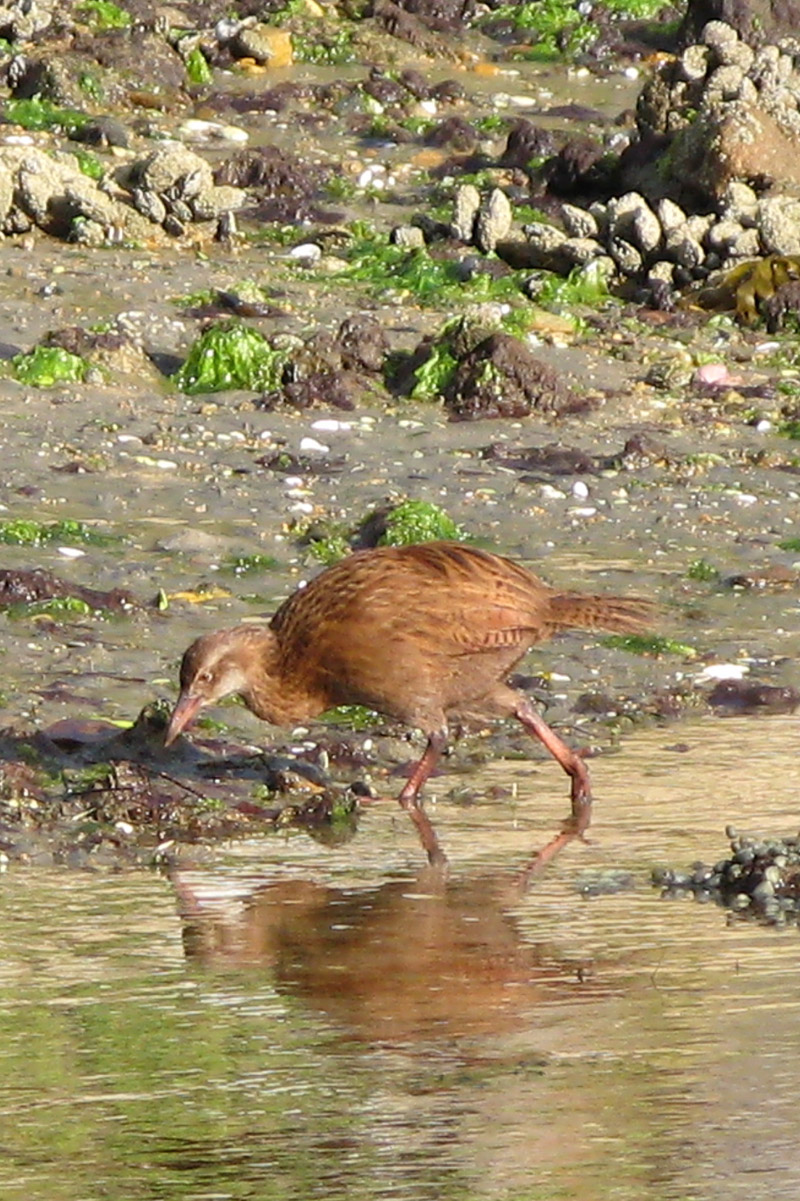 When it’s a Weka (pronounced “wehkkah”, Gallirallus australis), a biggish flightless endemic NZ rail.
When it’s a Weka (pronounced “wehkkah”, Gallirallus australis), a biggish flightless endemic NZ rail.
If you’ve ever tried to see a rail in the US, you know it can be an exercise in frustration, since our rails are furtive and well-camouflaged wetlands birds. Designed to slip secretly through reeds and sedges (as in “thin as a…”), they are far more often heard than seen.
Not so in Ulva Island NZ (a small refuge islet just offshore of Stewart Island), where the Weka is common, and emerges from the bush in broad daylight to forage the low tide line on the beaches of the Island, where it looks like a chestnut-colored chicken with a project. In this habitat, Weka function as diurnal Kiwi birds, because they occupy roughly the same niche as the Kiwi, who also leave the forest for the small-invertebrate-rich strands, except usually at night.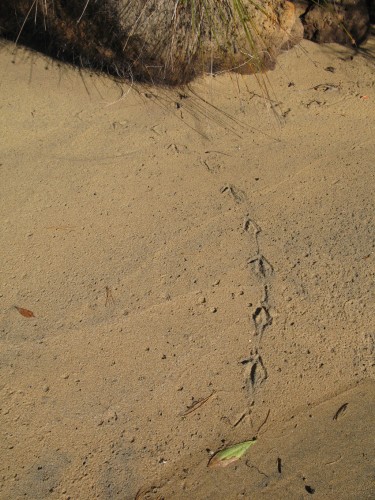
In fact, the indigenous name for the Stewart Island Brown Kiwi is Tokoeka, which according to some means “Weka with a Walkingstick” (the wooden kind, not the bug kind) in reference to the long bill of the otherwise similarly-shaped Kiwi bird. One beach we visited had four in the vicinity, but if you should by chance miss the Weka, look for the undulating lines of big-toed footprints leading out of the bush.
(Photos by A. Shock)
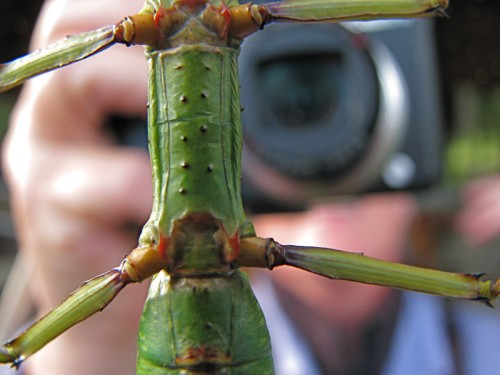 …how the photo E was taking turned out (from this post), here it is. Now you know what the ventral surface of a NZ walking stick looks like.
…how the photo E was taking turned out (from this post), here it is. Now you know what the ventral surface of a NZ walking stick looks like.
Proper Kiwi birds are nearly impossible to take photos of. Mainly because most kiwi birds are nocturnal and using flash is rude, but also because they’re hard to see in their environment, rummaging around in the deep ferny forest floor. And anyway they’re terribly difficult to find at all.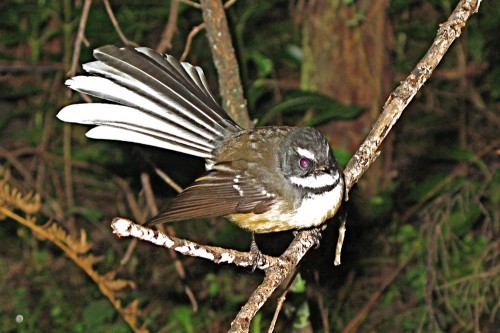
But there are other, non-Kiwi birds who are not so shy.
Piwakawaka is the exuberant Maori name for the Fantail (Rhipidura fuliginosa), a common native bird in New Zealand bush (areas forested with native trees and plants). This is one cheeky chicky: they’ll flit right up and swoop in to capture any bugs that may be hanging out around you as you hike, sometimes following for quite a distance down the trail, sometimes nearly — but not quite — landing on you.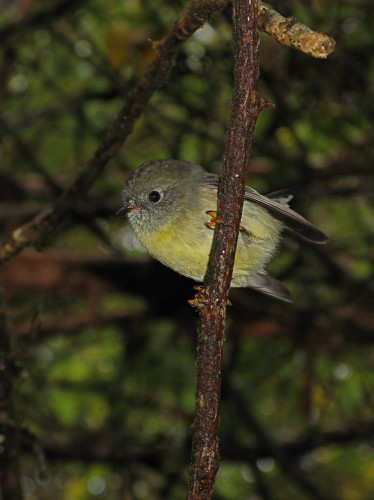
A couple of other birds do the same thing: the engaging Miromiro (Tomtit, Petroica macrocephala), the more reserved Toutouwai (New Zealand Robin, Petroica australis), so they are relatively easily photographed. (These last two birds, the NZ Robin and the Tomtit are endemic to NZ, occurring nowhere else, while the Fantail also lives in Australia).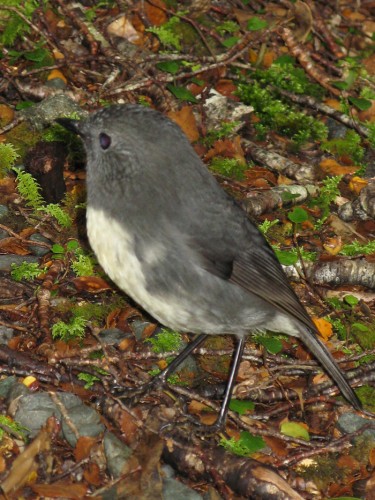
Top to bottom, here are photos of Piwakawaka (Fantail), an immature Miromiro (Tomtit), and Toutouwai (NZ Robin) (Photos by A. Shock).
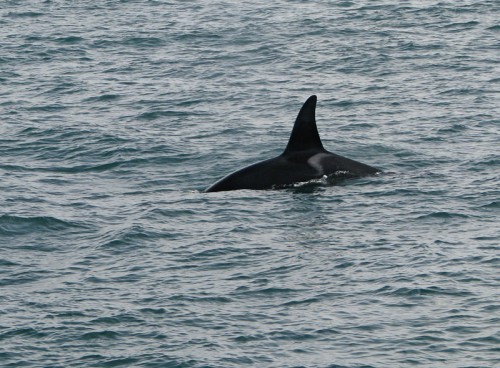 NZ has lots of coastline, and there are plenty of opportunities to get out onto the sea. During ferry trips, either getting to offshore islands or between big islands, or on small boats looking for sea birds, there’s almost always something to see — and not always birds.
NZ has lots of coastline, and there are plenty of opportunities to get out onto the sea. During ferry trips, either getting to offshore islands or between big islands, or on small boats looking for sea birds, there’s almost always something to see — and not always birds.
Returning to the mainland from Tiri Tiri Matangi, the ferry captain spied a pod of orca feeding on sting rays in the relatively shallow water of the Hauraki Gulf — here’s the dorsal fin of a male.
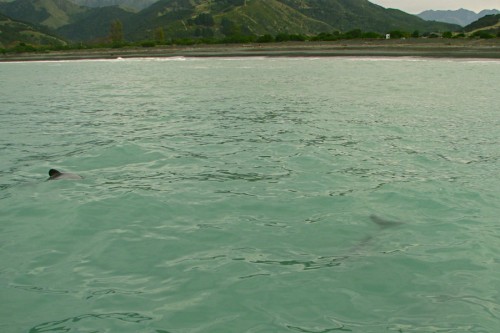 On a pelagic trip off Kaikoura, eastern South Island, we came across a small group of endangered Hector’s dolphins — quite tiny dolphins with distinctive paddle-shaped dorsal fins. There are actually two dolphins in this photo. They’re a bit difficult to see, but there’s a dorsal fin visible on the left edge of the picture, and near the bottom right, (especially if you enlarge by clicking) you can see the shadow of a little dolphin just under the surface. These guys were a bit shy, and didn’t sport around the boat.
On a pelagic trip off Kaikoura, eastern South Island, we came across a small group of endangered Hector’s dolphins — quite tiny dolphins with distinctive paddle-shaped dorsal fins. There are actually two dolphins in this photo. They’re a bit difficult to see, but there’s a dorsal fin visible on the left edge of the picture, and near the bottom right, (especially if you enlarge by clicking) you can see the shadow of a little dolphin just under the surface. These guys were a bit shy, and didn’t sport around the boat.
(Photos E Shock)
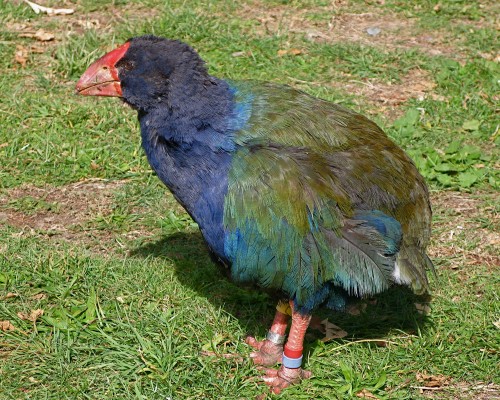 …that’s the Takahe, a mountain-dwelling, tussock-eating, big-beaked member of the gallinule family (related to coots). The bird was believed by ornithologists to be extinct, until G.B. Orbell “rediscovered” a population in the remote Murchison mountains of Fjordland New Zealand in 1948. Since then heroic efforts have been made to secure its survival as a species, which are so far uncertainly successful (in 2004, there were fewer than 200 birds in the wild, and less than 50 in captivity).
…that’s the Takahe, a mountain-dwelling, tussock-eating, big-beaked member of the gallinule family (related to coots). The bird was believed by ornithologists to be extinct, until G.B. Orbell “rediscovered” a population in the remote Murchison mountains of Fjordland New Zealand in 1948. Since then heroic efforts have been made to secure its survival as a species, which are so far uncertainly successful (in 2004, there were fewer than 200 birds in the wild, and less than 50 in captivity).
Above is a free-living wild Takahe, photographed on Tiri Tiri Matangi sanctuary in the North Island of New Zealand — I’m uncertain that it appears to appreciate all the effort taken on its behalf.
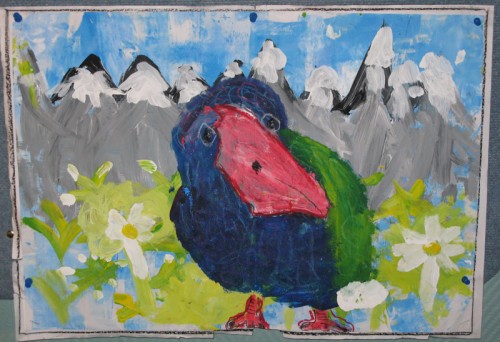 Then take a look at the most excellent kid’s painting tacked to a wall (no name supplied) at the Fjordlands National Park Visitors Center in Te Anau. Isn’t it perfect?
Then take a look at the most excellent kid’s painting tacked to a wall (no name supplied) at the Fjordlands National Park Visitors Center in Te Anau. Isn’t it perfect?
(Photos A. Shock)
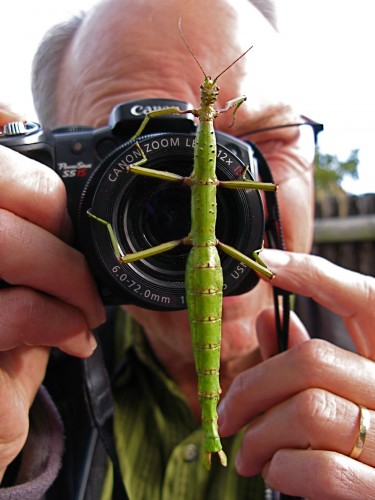 Here is E, making a new friend in the Kauri Forest. It may be big and green, but at least it doesn’t bite, like the Sand flies.
Here is E, making a new friend in the Kauri Forest. It may be big and green, but at least it doesn’t bite, like the Sand flies.
(Photo A. Shock)
 When it’s a Weka (pronounced “wehkkah”, Gallirallus australis), a biggish flightless endemic NZ rail.
When it’s a Weka (pronounced “wehkkah”, Gallirallus australis), a biggish flightless endemic NZ rail.









